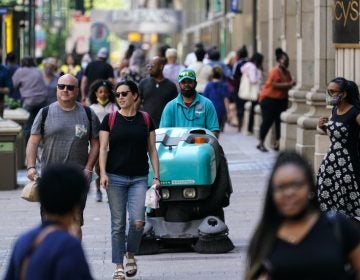Penn Charter contributes to PIFA’s “If She Stood” exhibit
For William Penn Charter School 11th-graders and their teachers, the Philadelphia International Festival of the Arts was an unexpected chance to make the ultimate twenty-first century classroom by going back in time.
Lee Payton, head of Penn Charter’s Social Studies Department, and Cheryl Irving, Writing Center staffer and director of the school’s Multicultural Resource Center, have teamed up for the past two years to offer juniors the American Studies Course.
“It’s a fully-integrated, interdisciplinary team-taught course that mixes American literature and American history,” Irving explains.
Philadelphia’s female abolitionists
Meanwhile, Penn Charter parent and Painted Bride Art Center Associate Director Lisa Nelson-Haynes was gearing up for a special PIFA event at her venue: a world-premiere theatrical play based on the 1833 founding of the multi-racial Philadelphia Female Anti-Slavery Society.
“If She Stood,” which opens April 26, was commissioned by the Painted Bride (sponsored in part by the Pew Center for Arts and Heritage) and grew out of a collaboration between playwright Ain Gordon and filmmaker Nadine Patterson.
The play follows historical figures like Sarah Mapps Douglass, Sarah Grimke, Angelina Weld Grimké and Sarah Pugh, women who are little-known today, but who had a major impact on Philadelphia’s civil-rights landscape.
Lessons come to life
The show got on Penn Charter’s radar in part because Nelson-Haynes and Payton happen to be neighbors, and they got to chatting about the new play, which grew out of detailed historical research.
“Wow,” Payton said then, realizing it was a real-world example of what they were trying to build in the classroom: “The paradigm of our course is history informing literature and vice versa.” He invited the artists involved to speak to his class about their process.
Payton and Irving soon learned that “If She Stood” was only one part of the PIFA event at the Painted Bride.
Patterson was also curating an accompanying “Philadelphia Community Lyceum” that would be installed there for seven weeks, featuring workshops, lectures, readings, films, and visual and literary arts exploring the socio-political movements of Philadelphia’s past, including abolition, women’s suffrage and education.
Instead of simply producing a companion film, “I thought a gallery exhibit would be a better way to create a context for the play, and give people time to learn and get excited about the concept in the play,” Patterson says.
The gallery, which opened on April 5 and will continue through May 18, now includes historically-inspired work in mediums spanning photography, quilting, poetry, collage, sculpture and more.
The collective nature of that work meant Irving and Payton jumped at the chance for their students to develop pieces for the lyceum.
“They bring a freshness and [an] innovative look at things,” Patterson says of including young people in the project, also emphasizing the importance of cross-generational, interracial and intercultural dialogue in many mediums.
“History is not complete, and there [are] so many points of view. Depending on where you are, you’re seeing a totally different object, and that’s history,” Patterson adds.
Inside the Penn Charter projects
Irving and Payton’s students began their process last fall with a list of suggested historical topics from Gordon. Duos and trios of student teams each chose one topic, including the Indian Removal Act, the opening of Eastern State Penitentiary, Laurel Hill Cemetery, and the economics of 1830s America.
Payton guided the students in developing well-researched pamphlets on their chosen topics. Then, Irving helped students unleash their creative thinking, developing original short stories based on what they had learned. The teens completed the process with a visual arts component, including digitally edited photography, drawings and collage.
“There’s a different kind of academic intellectual rigor that’s happening there. You see kids working really hard to fine-tune the image,” Payton says.
The students’ short stories are now available for reading in the Painted Bride gallery, along with their artwork, including a detailed map of the Trail of Tears and a collage of African-American leaders from Harriet Tubman and Frederick Douglass to Martin Luther King Jr. and President Obama.
The truth about modern learning
“Twenty-first century learning means lots of things to lots of people,” Payton says, noting that this is often shorthand for classrooms well-equipped with the internet and digital technology. But he and Irving agree that the real cutting edge of education is a collaborative, interdisciplinary, real-world approach.
“This is going beyond the walls of our school,” Irving adds of why the kids’ projects stood out, versus more traditional learning methods like assigned reading and exams.
The teachers say the partnership with the Painted Bride modeled collaboration on every level, from connecting the classroom with a public cultural center and having the students work in teams to the unique model of two classroom leaders working in tandem.
For Payton, the things that should define twenty-first century learning are “making connections across a broad range of traditional disciplines,” leaving behind a test or quiz-driven mentality, and orienting the high schoolers’ work to the real world: in this case, the chance to share their projects with the city.
From the beginning of the American Studies class that allowed the kids to dive into PIFA, “we’ve been working with twenty-first century skills and concepts that we think will serve these kids well long after they’ve left Penn Charter,” Irving concludes.
“Freedom, Fire and Promiscuous Meetings: The Philadelphia Community Lyceum” is open at the Painted Bride Art Center through May 18, Tuesday-Saturday from 12 to 6 p.m. Tickets for “If She Stood” ($18.75-$30), April 26 to April 28 and May 3 to May 5, are on sale now through the Painted Bride’s website.
WHYY is your source for fact-based, in-depth journalism and information. As a nonprofit organization, we rely on financial support from readers like you. Please give today.




